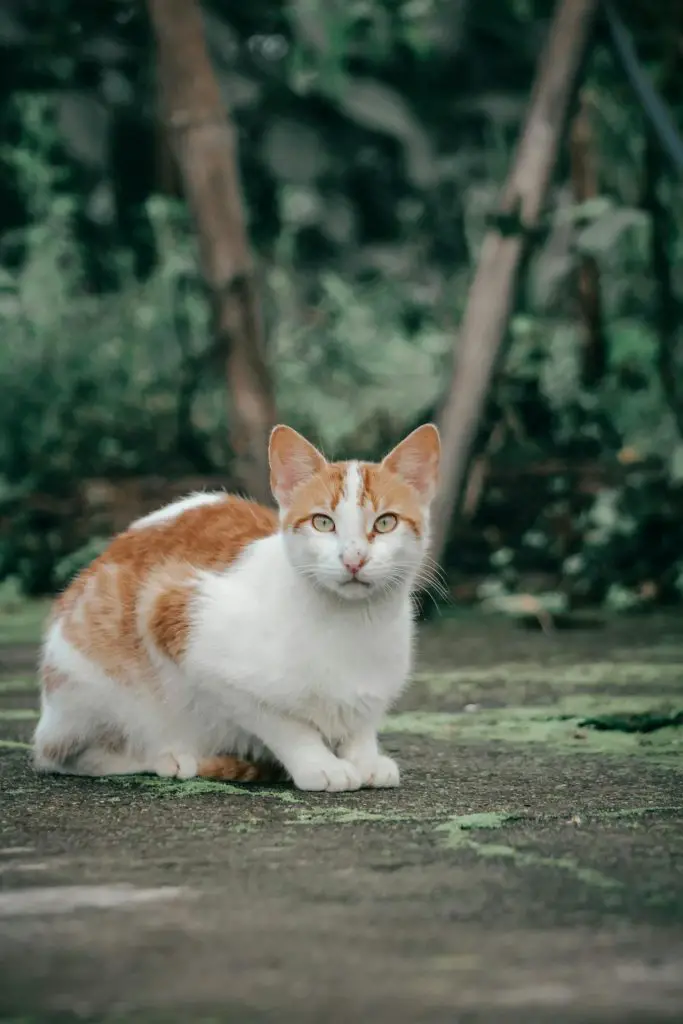
Training your cat to pee outside involves selecting a private, secure spot with a texture similar to their current litter.
Gradually shift by moving their litter box closer to this outdoor area.
Use temporary outdoor litter boxes with soil or sand.
Utilize positive reinforcement, offering treats and praise for successful behavior.
Monitor for stress and guarantee the environment is free of hazards. Regularly clean and maintain the area to encourage continued use.
Address any environmental or health challenges that may arise.
This post contains affiliate links. However all the information provided on this site are my own honest opinions. See more in Disclaimer.
There’s more to discover about creating seamless outdoor habits for your feline companion.
Table of Contents
Key Takeaways

- Gradually move the litter box closer to the designated outdoor area to ease transition.
- Select a private, hazard-free outdoor spot with familiar textures like soft soil or sand.
- Use positive reinforcement, such as treats and praise, after successful outdoor peeing.
- Regularly clean the outdoor area to maintain hygiene and attract the cat.
Understand Your Cat’s Needs
To effectively train your cat to pee outside, you must first understand their natural behaviors and instincts regarding elimination.

Cats are inherently clean animals and have a strong preference for particular types of surfaces when eliminating. Observing your cat’s behavior around litter boxes can provide valuable insights into their preferences.
Cats often exhibit specific litter preferences, which can be quite diverse. Some cats prefer fine, sandy textures, while others lean towards coarser materials.
Additionally, their elimination behavior is influenced by their need for a secure and private environment.
If your cat feels threatened or exposed, they may develop inappropriate elimination habits. Understanding these preferences and behaviors is essential.
For example, if your cat favors a specific type of litter, shifting them to an outdoor environment with a similar texture can facilitate the training process. See also our post on 6 Amazing Facts About Cat Sleeping Habits.
Furthermore, cats are territorial and mark their territory through elimination. Recognizing their need for a consistent and familiar spot can aid in the outdoor training process.
Choose the Right Spot
When selecting the ideal location for your cat to pee outside, prioritize a spot that offers both privacy and a familiar texture similar to their preferred litter.

This approach guarantees your cat feels secure and comfortable, reducing the likelihood of accidents elsewhere. Look for areas with soft soil or sand, as these textures closely mimic common litter box alternatives.
Outdoor safety is paramount when choosing the spot. Confirm the area is free from potential hazards such as toxic plants, sharp objects, or busy roads.
A secluded corner of your yard can provide the necessary privacy while minimizing exposure to potential threats.
Additionally, consider installing a small fence or barrier to create a defined, safe zone for your cat. It’s also essential to maintain the cleanliness of this designated area.
Regularly remove any waste to prevent odors and discourage your cat from seeking alternative locations.
Monitoring the spot for any signs of pests or unwanted animals can further enhance outdoor safety.
Gradual Transition Techniques
Once you’ve chosen the right spot, start by gradually moving your cat’s litter box closer to the designated outdoor area.
This incremental approach helps your cat acclimate to the new environment while maintaining familiar routines. Begin by shifting the litter box a few feet every day, guaranteeing minimal stress for your feline companion.
During this change, consider integrating litter box alternatives. For instance, a temporary outdoor litter box filled with natural substrates like soil or sand can be an effective intermediary step.
This mimics the outdoor environment and prepares your cat for the final change.
Make sure the temporary outdoor litter box is in a sheltered location to protect it from the elements. Outdoor safety is paramount during this process.
Monitor your cat’s behavior closely and address any signs of anxiety or distress.
It’s essential to maintain a secure and supervised environment to prevent potential hazards, such as traffic or predators.
You may also want to install a cat flap or create a safe outdoor enclosure to facilitate easy access to the new peeing spot. Also read our post on 7 Secrets To Keep Cats Out Of The Garden.
Encourage Outdoor Exploration
Encouraging outdoor exploration is essential for helping your cat become comfortable with their new peeing environment.

Start by gradually introducing your cat to the outdoors. Monitor their cat behavior to guarantee they’re adapting well and not exhibiting signs of stress or fear.
Initially, keep these sessions short and controlled, preferably in a fenced yard, to prioritize outdoor safety. Use the following table to guide your cat’s exploratory sessions:
| Session Duration | Frequency | Supervision Required | Notes |
|---|---|---|---|
| 10-15 minutes | Once daily | Constant | Observe for stress indicators |
| 20-30 minutes | Twice weekly | Partial | Allow for more independence |
| 30-45 minutes | Thrice weekly | Minimal | Begin introducing peeing areas |
| 1 hour | Weekly | Occasional | Guarantee safety and comfort |
Gradually increase the duration and frequency of outdoor time while maintaining a balance between supervision and independence. Guarantee your cat is vaccinated and protected against parasites to mitigate outdoor safety risks.
During these sessions, familiarize them with potential peeing spots by letting them explore different areas of the yard.
Use Positive Reinforcement
After establishing a comfortable outdoor routine, reinforce your cat’s positive behaviors by using rewards and praise each time they successfully pee outside.

Implementing clicker training can be a highly effective method. When your cat eliminates outside, immediately use the clicker to create an auditory cue that signifies a positive action.
This technique relies on precise reward timing to strengthen the association between the behavior and the reward.
Once the clicker has been activated, promptly offer a high-value treat that your cat finds particularly motivating. This immediate reinforcement guarantees that your cat clearly understands which specific behavior is being rewarded.
In addition, verbal praise can complement the clicker and treat, further solidifying the positive experience.
It’s essential to remain consistent with your reinforcement strategy. Every successful outdoor elimination should be met with the same level of reward and encouragement.
This consistency helps to reliably shape your cat’s behavior over time.
Addressing Challenges
Although training your cat to pee outside can be highly rewarding, you may encounter several challenges that require strategic problem-solving.
Understanding and addressing these challenges is essential for successful outdoor elimination training.
Behavioral issues can be a primary obstacle. Some cats may exhibit anxiety or reluctance to change their peeing habits. This can be due to previous negative experiences or a natural aversion to new routines.
To mitigate these issues, gradually acclimate your cat to the outdoor environment and provide positive reinforcement consistently.
Environmental factors also play a noteworthy role. Adverse weather conditions, unfamiliar scents, and the presence of other animals can deter your cat from peeing outside.
Selecting an ideal outdoor spot that’s sheltered and free from disturbances is crucial.
Additionally, you might face issues related to your cat’s health. Medical conditions such as urinary tract infections can greatly impact your cat’s elimination behavior.
It’s essential to rule out any health concerns with a veterinarian before proceeding with outdoor training.
To effectively address these challenges, consider the following:
- Gradual desensitization to reduce anxiety.
- Selection of an appropriate, sheltered outdoor spot.
- Regular veterinary check-ups to eliminate health concerns.
Maintain Outdoor Hygiene
Once you’ve addressed the initial challenges, maintaining outdoor hygiene is vital to guarantee your cat continues to use the designated area for peeing.
Regularly clean the area to prevent the buildup of waste and to minimize odors, making it a more inviting spot for your cat.
Utilizing litter box alternatives such as sand, soil, or specific outdoor cat litter can also help maintain cleanliness. These alternatives should be replaced frequently to confirm the area remains hygienic.
It’s essential to monitor the designated area for any signs of contamination from other animals. Outdoor safety measures, such as fencing or barriers, can deter other pets or wildlife from accessing your cat’s peeing spot.
This not only keeps the area cleaner but also reduces the risk of territorial conflicts and potential health issues.
You should also be mindful of the local environment. Select a location that’s away from water sources and edible plants to prevent contamination. Regularly check for any hazardous materials or plants that could harm your cat.
Frequently Asked Questions

To address neighborhood cats using the same spot, employ neighborhood cat deterrents like motion-activated sprinklers. Establishing your cat’s outdoor cat territory with specific markers can also discourage others. Consistent monitoring will guarantee effective results.
Training your cat to pee outside might impact its litter box usage. However, introducing litter box alternatives and consistent cat behavior modifications can help maintain its indoor habits while adapting to outdoor elimination.
Yes, weather conditions can impact your cat’s willingness to pee outside. Cats have specific weather preferences. You’ll need to make seasonal adjustments to accommodate their comfort, ensuring they venture out despite adverse conditions.
Imagine your cat as a curious explorer. Guarantee their safety by providing outdoor supervision and creating a safe environment. Monitor for potential hazards and keep vaccinations up-to-date to minimize health risks while they’re outside.
If your cat has health issues affecting its bathroom habits, consult a veterinarian for health assessments. They’ll recommend behavioral modifications and medical interventions to guarantee your cat’s well-being and proper management of its unique health needs.
Conclusion

In summary, understanding your cat’s needs, choosing the right spot, and employing gradual change techniques are essential.
Encouraging outdoor exploration, using positive reinforcement, and addressing challenges will facilitate success.
Maintaining outdoor hygiene guarantees a healthy environment.
By following these steps, you’ll foster a seamless change, promote proper behavior, and guarantee your cat’s well-being.
Consistency, patience, and persistence are key.
Equip yourself with these strategies, and you’ll confidently guide your cat to pee outside effectively.










